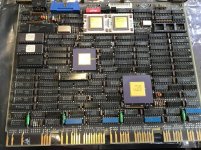The people of 2155 are going to be screwed when their rsx11 boxes crash.
I'll let you in on a secret - I keep my systems set to dates in the 80's and 90's. No date issues no matter what software I'm running.
After all, what does it matter what the year is?
Just pick a year where the days of the week and the numeric date align with the current one and you're all set.
This year,
2012 matches 1984 perfectly. It began on Jan 1 = Sunday, and It's a leap year. You can even re-use a 1984 Calendar if you wish.
Quick story:
In the days of RSX11M 3.0...
Our R&D department used to occasionally deal with a contractor. This contractor's development system would not handle "comments" in it's assembly files. So, whenever we got modifications back from this guy, all our comments were stripped from it, and his changes had none either. Over time, one product he habitually cared for grew to 10k+ lines of assembly code, and not a single comment in it!
We couldn't do anything about it, as management (the Director of R&D) was a friend of this dude. Eventually the time came when this contractor was busy for a set of changes that had to be made, and we in engineering had to take up the task of making and debugging the latest modifications.
Well, during this horribly hot summer, I helped one of our co-op students completely revise and comment the entire code set during "shutdown month". Poor Tom, he slaved like a dog to get it done! As my department was the only one in the building with the A/C on [ours was an independent system], he moved into my area and I got to hear all the cursing and foul language as he figured out what 10k lines of code was doing.
At the end, we had a very nice package that was maintainable, and better still - all the listing files were at their final addresses [no more relocation] so debugging in the hardware was a snap. Listings had a symbol cross-reference and everything. We could make real, predictable progress with changes from there out. FINALLY!
Well, a couple months later, management wanted more changes... and their favorite contractor was available again.
Tom was in a panic... he came to me - angry as if someone had doused him with a bucket of fish guts. "What are we gonna do? I'll quit before I give this a_____e my commented code!". [yes - by this time we'd hired Tom, partly because of the good job he'd done with what had become known as an impossible product] A little brainstorming presented the answer. We modified a program I'd written to extract comments out of sources for documentation purposes, and made it also output the code (sans the comments, which it could already recognize) to a like-named file in another directory.
It took a few minutes to run, and we had a set of sources back in the same condition we'd last received them.
Why did I think of this now? As a little hint to the guy, I set the system date for this creation of files to "Sunday, December 7, 1941", and that's how they were all time stamped. RSX never checked and didn't care.
So unless they changed it, RSX will probably accept any date you care to set. Hi Tom... you reading this??



